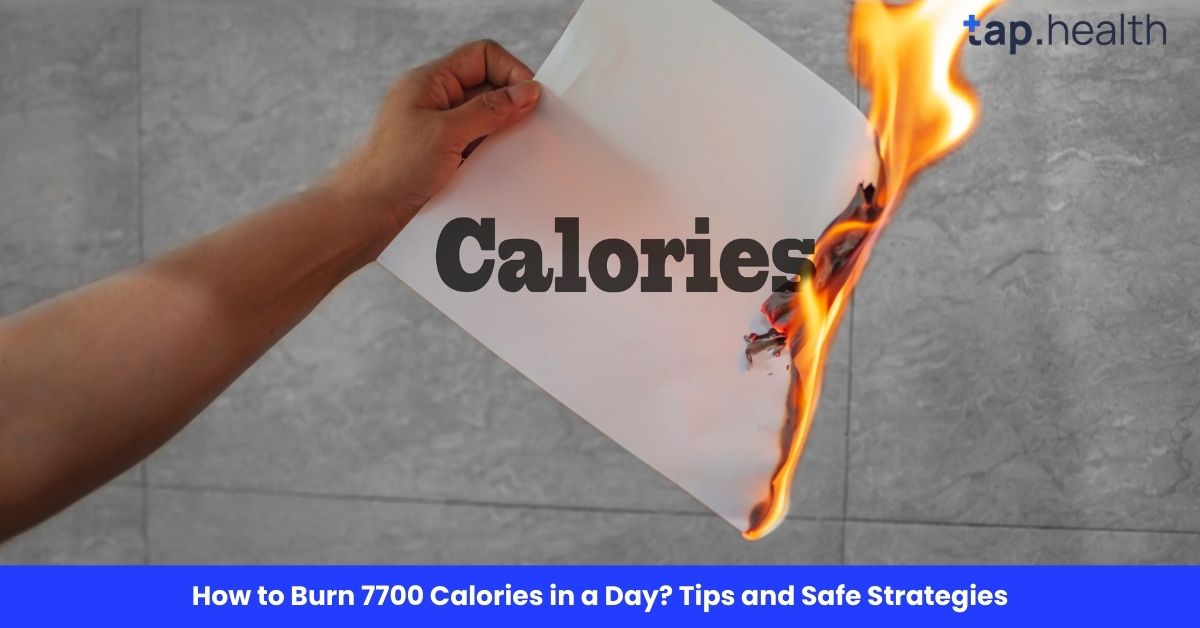Burning 7700 calories in a single day may sound like an impossible challenge, but it is possible if you know the right approach and methods. Whether you’re looking to lose weight, train for an event, or just curious about the science behind calorie burning, understanding how to burn such a large number of calories can be both helpful and eye-opening.
Before diving into specific strategies, it’s important to note that burning 7700 calories in one day is extreme, and not recommended for everyone. This number is often cited as the approximate number of calories needed to lose 1 kilogram (2.2 pounds) of body fat. However, attempting to burn this many calories in one day can be dangerous if not approached carefully.
In this article, we’ll explore different activities and techniques that can help you burn a large number of calories, along with the necessary precautions to ensure safety. Let’s get started!
Understanding the Concept of Calories
Before we get into how to burn 7700 calories in a day, let’s first understand what a calorie is and how it relates to energy. A calorie is a unit of energy that your body uses to perform daily activities, from basic bodily functions like breathing and digestion to more physical activities like walking or running.
The number of calories you burn each day is influenced by several factors:
- Basal Metabolic Rate (BMR): This is the number of calories your body needs to maintain basic functions at rest, like breathing and keeping your heart beating.
- Physical Activity: Any exercise or movement you do, such as walking, running, or lifting weights, burns calories.
- Thermic Effect of Food (TEF): This refers to the calories your body burns to digest and process food.
The total number of calories burned in a day depends on how much energy your body needs for all of these functions.
How Much Exercise Is Needed to Burn 7700 Calories?
To burn 7700 calories in a day, you’ll need to engage in intense and sustained physical activity. It’s important to understand that the more you weigh, the more calories you burn during physical activity, but it’s also important to know that this kind of calorie burn is typically beyond the capabilities of normal daily activity. Here are some activities and their estimated calorie burns for a 155-pound (70 kg) individual.
High-Intensity Running
Running at a fast pace (around 6 miles per hour or a 10-minute mile pace) burns about 700-800 calories per hour for a person weighing 155 pounds.
To burn 7700 calories through running, you would need to run continuously for about 9-11 hours at that pace. Clearly, this is not sustainable for most people and could be harmful without proper conditioning, hydration, and nutrition.
Cycling at High Intensity
Cycling at a high intensity (such as at 14-16 miles per hour) can burn around 600-800 calories per hour, depending on your effort level and terrain.
To burn 7700 calories, you would need to cycle for about 10-12 hours straight, which again is not practical for most individuals. High endurance cycling can be effective for long-term calorie burning, but in one day, this would be an extreme and potentially unsafe approach.
Jumping Rope
Jumping rope is an excellent calorie-burning exercise that can burn about 600-900 calories per hour, depending on your intensity and pace.
To burn 7700 calories, you would need to jump rope for around 9-13 hours. While jumping rope can be a fun and effective way to burn calories, doing it for such a long period could result in serious injury or exhaustion.
Swimming
Swimming is another high-calorie burning activity, and depending on the stroke and intensity, it can burn around 500-700 calories per hour.
To burn 7700 calories in one day, you would need to swim for about 11-15 hours. Swimming is a low-impact exercise, which makes it less stressful on your joints, but such extended durations of swimming would still be difficult and risky.
Walking
Walking at a moderate pace (about 3-4 miles per hour) burns around 250-350 calories per hour.
To burn 7700 calories through walking alone, it would take you about 22-30 hours of continuous walking. While walking is a great way to burn calories and is much more manageable than running, walking for such extended periods of time isn’t realistic or sustainable.
How to Safely Approach Burning 7700 Calories
Burning 7700 calories in one day is not something most people should attempt, especially without professional supervision or training. If you are considering trying to burn a significant number of calories, here are some tips to do it more safely and effectively:
1. Combine Different Activities
Instead of trying to burn all the calories with one type of exercise, it’s better to mix different activities. For example, you could run for a few hours, cycle for a few more, and finish with a long walk. This combination will reduce strain on any one part of your body and make it easier to sustain throughout the day.
2. Build Up Gradually
If your goal is to increase the number of calories you burn in a day, it’s essential to build up gradually. Attempting to burn 7700 calories in a single day without proper training can result in injuries or exhaustion. Start with smaller, more manageable goals, and work your way up.
3. Take Frequent Breaks
If you plan to engage in long periods of physical activity, taking breaks is crucial. Resting will help your body recover, preventing fatigue and injury. Even professional athletes take breaks during long training sessions.
4. Hydrate and Eat Properly
Engaging in high-calorie-burning exercises requires proper nutrition and hydration. Make sure to stay hydrated throughout the day and eat healthy meals to fuel your body. Carbohydrates, proteins, and healthy fats are essential for maintaining energy levels and supporting recovery after exercise.
5. Prioritize Safety
Above all, your health and safety should come first. If you’re planning to burn an extremely high number of calories in one day, it’s best to consult with a doctor or fitness expert. Overdoing it can lead to serious injuries, dehydration, or exhaustion.
How to Burn Calories Effectively in a Healthy Way
If you’re looking for a more reasonable approach to burning calories and losing weight, it’s better to take a sustainable and balanced approach. Here are some tips for burning calories effectively:
1. Regular Exercise Routine
Incorporating regular exercise into your daily routine will help you burn calories consistently over time. Aim for at least 30 minutes of moderate to intense exercise most days of the week. This can include activities like walking, running, cycling, or strength training.
2. Monitor Your Diet
Diet plays a significant role in weight loss and calorie burning. A balanced diet rich in fruits, vegetables, lean proteins, and whole grains will support your exercise efforts. Eating fewer processed foods and sugars can help you maintain a healthy weight.
3. Active Lifestyle
In addition to structured workouts, make sure to stay active throughout the day. Simple activities like taking the stairs, walking instead of driving, or standing at your desk can add up to significant calorie burn over time.
Real-Life Scenario
A 70-kg person would need to run about 18–20 hours non-stop to burn 7700 calories in a single day. This is nearly impossible and dangerous. A more realistic strategy would be to aim for 500–800 calories burned daily through workouts like brisk walking, cycling, swimming, or gym sessions, paired with mindful eating. Over 10–15 days, the body can naturally reach that 7700-calorie deficit without stress.
Expert Contribution
Health experts and fitness trainers emphasize that slow and steady weight loss is safer and more effective. According to the Mayo Clinic and other research-backed institutions, losing more than 1–1.5 kg per week can increase the risk of muscle loss, nutritional deficiencies, and gallstones.
Doctors also warn that over-exercising to burn extreme calories in one day can lead to dehydration, heart strain, injuries, and burnout.
Recommendations Grounded in Proven Research and Facts
- Set realistic goals: Aim to burn 500–1000 calories a day through a mix of diet and exercise.
- Focus on strength + cardio: Weight training boosts metabolism, while cardio helps burn calories.
- Eat a balanced diet: High-protein foods, fiber, and healthy fats keep you full while reducing overall calorie intake.
- Stay consistent: A steady 7700-calorie deficit spread over days or weeks is the safest path to losing 1 kg.
- Avoid crash methods: Skipping meals or over-exercising can damage health long-term.
Frequently Asked Questions (FAQs) on How to Burn 7700 Calories in a Day?
1. How many hours of running does it take to burn 7700 calories?
To burn 7700 calories, you would need to run for about 9-11 hours at a moderate pace of 6 miles per hour (10-minute mile). This is not a practical or safe approach for most people.
2. Can I burn 7700 calories in one day with just exercise?
While it’s possible, burning 7700 calories in one day through exercise alone is extremely difficult and dangerous for most people. It’s better to take a more gradual and balanced approach to burning calories.
3. How can I burn a lot of calories quickly?
To burn a lot of calories quickly, high-intensity exercises like running, cycling, or jumping rope are your best bet. However, it’s important to balance intensity with safety and endurance.
4. Is it safe to burn 7700 calories in a single day?
Burning 7700 calories in one day is not recommended unless you’re a highly trained athlete and under proper supervision. For most people, this is an extreme goal that could lead to exhaustion, dehydration, and injury.
5. How many calories should I burn a day for weight loss?
For healthy weight loss, aim to burn 500-1000 calories more than you consume each day. This can help you lose 1 to 2 pounds of body weight per week, which is a safe and sustainable rate.
Conclusion
Burning 7700 calories in a single day is an extreme challenge that requires intense physical activity and a high level of endurance. While it is theoretically possible, it’s not recommended for most people due to the risks involved. If you’re looking to burn calories effectively and safely, it’s better to adopt a balanced approach that includes regular exercise, a healthy diet, and adequate rest. Always prioritize safety and listen to your body as you work toward your fitness goals.



